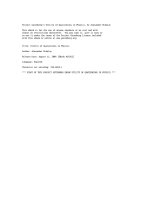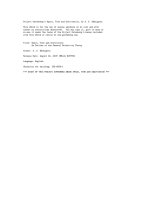Project Gutenberg’s Theory of Groups of Finite Order, by William Burnside pptx
Bạn đang xem bản rút gọn của tài liệu. Xem và tải ngay bản đầy đủ của tài liệu tại đây (3.85 MB, 456 trang )
Project Gutenberg’s Theory of Groups of Finite Order, by William Burnside
This eBook is for the use of anyone anywhere at no cost and with
almost no restrictions whatsoever. You may copy it, give it away or
re-use it under the terms of the Project Gutenberg License included
with this eBook or online at www.gutenberg.org
Title: Theory of Groups of Finite Order
Author: William Burnside
Release Date: August 2, 2012 [EBook #40395]
Language: English
Character set encoding: ISO-8859-1
*** START OF THIS PROJECT GUTENBERG EBOOK THEORY OF GROUPS OF FINITE ORDER ***
Produced by Andrew D. Hwang, Brenda Lewis, and the Online
Distributed Proofreading Team at (This
file was produced from images generously made available
by The Internet Archive/American Libraries.)
Transcriber’s Note
Minor typographical corrections, presentational changes, and regu-
larizations of mathematical notation have been made without com-
ment. All changes are detailed in the L
A
T
E
X source file, which may
be downloaded from
www.gutenberg.org/ebooks/40395.
This PDF file is optimized for screen viewing, but may easily be
recompiled for printing. Please consult the preamble of the L
A
T
E
X
source file for instructions.
THEORY OF GROUPS
OF
FINITE ORDER.
London: C. J. CLAY and SONS,
CAMBRIDGE UNIVERSITY PRESS WAREHOUSE,
AVE MARIA LANE.
Glasgow: 263, ARGYLE STREET.
Leipzig: F. A. BROCKHAUS.
New York: THE MACMILLAN COMPANY.
THEORY OF GROUPS
OF
FINITE ORDER
BY
W. BURNSIDE, M.A., F.R.S.,
LATE FELLOW OF PEMBROKE COLLEGE, CAMBRIDGE;
PROFESSOR OF MATHEMATICS AT THE ROYAL NAVAL COLLEGE, GREENWICH.
CAMBRIDGE:
AT THE UNIVERSITY PRESS.
1897
[All Rights reserved.]
Cambridge:
PRINTED BY J. AND C. F. CLAY,
AT THE UNIVERSITY PRESS.
PREFACE.
The theory of groups of finite order may be said to date from the time
of Cauchy. To him are due the first attempts at classification with a view to
forming a theory from a number of isolated facts. Galois introduced into the
theory the exceedingly important idea of a self-conjugate sub-group, and
the corresponding division of groups into simple and composite. Moreover,
by shewing that to every equation of finite degree there corresponds a group
of finite order on which all the properties of the equation depend, Galois
indicated how far reaching the applications of the theory might be, and
thereby contributed greatly, if indirectly, to its subsequent developement.
Many additions were made, mainly by French mathematicians, during
the middle part of the century. The first connected exposition of the theory
was given in the third edition of M. Serret’s “Cours d’Algèbre Supérieure,”
which was published in 1866. This was followed in 1870 by M. Jordan’s
“Traité des substitutions et des équations algébriques.” The greater part of
M. Jordan’s treatise is devoted to a developement of the ideas of Galois
and to their application to the theory of equations.
No considerable progress in the theory, as apart from its applications,
was made till the appearance in 1872 of Herr Sylow’s memoir “Théorèmes
sur les groupes de substitutions” in the fifth volume of the Mathematische
Annalen. Since the date of this memoir, but more especially in recent
years, the theory has advanced continuously.
In 1882 appeared Herr Netto’s “Substitutionentheorie und ihre Anwen-
dungen auf die Algebra,” in which, as in M. Serret’s and M. Jordan’s works,
the subject is treated entirely from the point of view of groups of substi-
tutions. Last but not least among the works which give a detailed account
of the subject must be mentioned Herr Weber’s “Lehrbuch der Algebra,” of
which the first volume appeared in 1895 and the second in 1896. In the
last section of the first volume some of the more important properties of
substitution groups are given. In the first section of the second volume,
however, the subject is approached from a more general point of view, and
a theory of finite groups is developed which is quite independent of any
special mode of representing them.
The present treatise is intended to introduce to the reader the main
PREFACE. vi
outlines of the theory of groups of finite order apart from any applications.
The subject is one which has hitherto attracted but little attention in this
country; it will afford me much satisfaction if, by means of this book,
I shall succeed in arousing interest among English mathematicians in a
branch of pure mathematics which becomes the more fascinating the more
it is studied.
Cayley’s dictum that “a group is defined by means of the laws of combi-
nation of its symbols” would imply that, in dealing purely with the theory
of groups, no more concrete mode of representation should be used than is
absolutely necessary. It may then be asked why, in a book which professes
to leave all applications on one side, a considerable space is devoted to
substitution groups; while other particular modes of representation, such
as groups of linear transformations, are not even referred to. My answer
to this question is that while, in the present state of our knowledge, many
results in the pure theory are arrived at most readily by dealing with prop-
erties of substitution groups, it would be difficult to find a result that
could be most directly obtained by the consideration of groups of linear
transformations.
The plan of the book is as follows. The first Chapter has been devoted
to explaining the notation of substitutions. As this notation may not im-
probably be unfamiliar to many English readers, some such introduction is
necessary to make the illustrations used in the following chapters intelligi-
ble. Chapters II to VII deal with the more important properties of groups
which are independent of any special form of representation. The nota-
tion and methods of substitution groups have been rigorously excluded in
the proofs and investigations contained in these chapters; for the purposes
of illustration, however, the notation has been used whenever convenient.
Chapters VIII to X deal with those properties of groups which depend
on their representation as substitution groups. Chapter XI treats of the
isomorphism of a group with itself. Here, though the properties involved
are independent of the form of representation of the group, the methods of
substitution groups are partially employed. Graphical modes of represent-
ing a group are considered in Chapters XII and XIII. In Chapter XIV the
properties of a class of groups, of great importance in analysis, are inves-
tigated as a general illustration of the foregoing theory. The last Chapter
PREFACE. vii
contains a series of results in connection with the classification of groups
as simple, composite, or soluble.
A few illustrative examples have been given throughout the book. As
far as possible I have selected such examples as would serve to complete or
continue the discussion in the text where they occur.
In addition to the works by Serret, Jordan, Netto and Weber already
referred to, I have while writing this book consulted many original mem-
oirs. Of these I may specially mention, as having been of great use to me,
two by Herr Dyck published in the twentieth and twenty-second volumes of
the Mathematische Annalen with the title “Gruppentheoretische Studien”;
three by Herr Frobenius in the Berliner Sitzungsberichte for 1895 with the
titles, “Ueber endliche Gruppen,” “Ueber auflösbare Gruppen,” and “Ver-
allgemeinerung des Sylow’schen Satzes”; and one by Herr Hölder in the
forty-sixth volume of the Mathematische Annalen with the title “Bildung
zusammengesetzter Gruppen.” Whenever a result is taken from an origi-
nal memoir I have given a full reference; any omission to do so that may
possibly occur is due to an oversight on my part.
To Mr A. R. Forsyth, Sc.D., F.R.S., Fellow of Trinity College, Cam-
bridge, and Sadlerian Professor of Mathematics, and to Mr G. B. Mathews,
M.A., F.R.S., late Fellow of St John’s College, Cambridge, and formerly
Professor of Mathematics in the University of North Wales, I am under a
debt of gratitude for the care and patience with which they have read the
proof-sheets. Without the assistance they have so generously given me,
the errors and obscurities, which I can hardly hope to have entirely es-
caped, would have been far more numerous. I wish to express my grateful
thanks also to Prof. O. Hölder of Königsberg who very kindly read and
criticized parts of the last chapter. Finally I must thank the Syndics of
the University Press of Cambridge for the assistance they have rendered
in the publication of the book, and the whole Staff of the Press for the
painstaking and careful way in which the printing has been done.
W. BURNSIDE.
July, 1897.
CONTENTS.
CHAPTER I.
ON SUBSTITUTIONS.
§§ PAGE
1 Object of the chapter . . . . . . . . . . . . . . . . . . . . . 1
2 Definition of a substitution . . . . . . . . . . . . . . . . . 1
3–6 Notation for substitutions; cycles; products of substitu-
tions . . . . . . . . . . . . . . . . . . . . . . . . . . . 1–4
7, 8 Identical substitution; inverse substitutions; order of a sub-
stitution . . . . . . . . . . . . . . . . . . . . . . . . . . . 4–7
9, 10 Circular, regular, similar, and permutable substitutions . . 7–9
11 Transpositions; representation of a substitution as a prod-
uct of transpositions; odd and even substitutions . . . . . 10–13
CHAPTER II.
THE DEFINITION OF A GROUP.
12 Definition of a group . . . . . . . . . . . . . . . . . . 13–14
13 Identical operation . . . . . . . . . . . . . . . . . . . 14
14 Continuous, discontinuous, and mixed groups . . . . . . . . 14–16
15, 16 Order of an operation; products of operations . . . . . 16–19
17 Examples of groups of operations; multiplication table of a
group . . . . . . . . . . . . . . . . . . . . . . . . . . . 19–23
18, 19 Generating operations of a group; defining relations; simply
isomorphic groups . . . . . . . . . . . . . . . . . . 23–25
20 Dyck’s theorem . . . . . . . . . . . . . . . . . . . . . . 25–27
21 Various modes of representing groups . . . . . . . . . . . 27–29
CONTENTS. ix
CHAPTER III.
ON THE SIMPLER PROPERTIES OF A GROUP WHICH ARE INDEPENDENT
OF ITS MODE OF REPRESENTATION.
§§ PAGE
22, 23 Sub-groups; the order of a sub-group divides the order of
the group containing it; symbol for a group . . . . . . . . 29–31
24 Transforming one operation by another; conjugate opera-
tions and sub-groups; self-conjugate operations and sub-
groups; simple and composite groups . . . . . . . . . . . 31–33
25, 26 The operations of a group which are permutable with a
given operation or sub-group form a group; complete sets
of conjugate operations or sub-groups . . . . . . . . . . 34–37
27 Theorems on self-conjugate sub-groups; maximum sub-
groups; maximum self-conjugate sub-groups . . . . . 37–40
28–31 Multiply isomorphic groups; factor groups; direct product
of two groups . . . . . . . . . . . . . . . . . . . . . . . 40–45
32 General isomorphism between two groups . . . . . . . . . 45–46
33–35 Permutable groups; Examples . . . . . . . . . . . . 46–52
CHAPTER IV.
ON ABELIAN GROUPS.
36–38 Sub-groups of Abelian groups; every Abelian group is the
direct product of Abelian groups whose orders are powers
of different primes . . . . . . . . . . . . . . . . . . . . . . . 52–54
39 Limitation of the discussion to Abelian groups whose orders
are powers of primes . . . . . . . . . . . . . . . . . . . 54
40–44 Existence of a set of independent generating operations of
such a group; invariance of the orders of the generating
operations; symbol for Abelian group of given type . . . . 54–62
45–47 Determination of all types of sub-groups of a given Abelian
group . . . . . . . . . . . . . . . . . . . . . . . . . . . 62–66
48, 49 Properties of an Abelian group of type (1, 1, . . . , 1) . . . 66–68
50 Examples . . . . . . . . . . . . . . . . . . . . . . . . . . 68–70
CONTENTS. x
CHAPTER V.
ON GROUPS WHOSE ORDERS ARE POWERS OF PRIMES.
§§ PAGE
51 Object of the chapter . . . . . . . . . . . . . . . . . . . . . . 70
52 Every group whose order is the power of a prime contains
self-conjugate operations . . . . . . . . . . . . . . . . . 70
53–58 General properties of groups whose orders are powers of
primes . . . . . . . . . . . . . . . . . . . . . . . . . . . 70–79
59–61 The number of sub-groups of order p
s
of a group of or-
der p
m
, where p is a prime, is congruent to unity, (mod. p) 79–81
62, 63 Groups of order p
m
with a single sub-group of order p
s
. . 81–86
64–67 Groups of order p
m
with a self-conjugate cyclical sub-group
of order p
m−2
. . . . . . . . . . . . . . . . . . . . . . . . . 86–93
68 Distinct types of groups of orders p
2
and p
3
. . . . . . . . . 93–94
69–72 Distinct types of groups of order p
4
. . . . . . . . . . . . . 94–99
73, 74 Tables of groups of orders p
2
, p
3
, and p
4
. . . . . . . . . . . 99–102
75 Examples . . . . . . . . . . . . . . . . . . . . . . . . . . 102–104
CHAPTER VI.
ON SYLOW’S THEOREM.
76 Object of the chapter . . . . . . . . . . . . . . . . . . . . . . 104
77, 78 Proof of Sylow’s theorem . . . . . . . . . . . . . . . . . . 104–108
79–82 Direct consequences of Sylow’s theorem . . . . . . . . . 108–114
83–85 Distinct types of groups of orders pq (p and q being different
primes), 24, and 60 . . . . . . . . . . . . . . . . . . . . . 114–124
86 Generalization of Sylow’s theorem . . . . . . . . . . . . . . 124–126
87 Frobenius’s theorem . . . . . . . . . . . . . . . . . . . . . . 126–131
88 Groups with properties analogous to those of groups whose
orders are powers of primes . . . . . . . . . . . . . . 131–134
CONTENTS. xi
CHAPTER VII.
ON THE COMPOSITION-SERIES OF A GROUP.
§§ PAGE
89 The composition-series, composition-factors, and factor-
groups of a given group . . . . . . . . . . . . . . . . . . 134–135
90, 91 Invariance of the composition-series of a group . . . . . . . 135–138
92 The chief composition-series, or chief series of a group; its
invariance; construction of a composition-series from a chief
series . . . . . . . . . . . . . . . . . . . . . . . . . . . 138–140
93–95 Types of the factor-groups of a chief series; minimum self-
conjugate sub-groups . . . . . . . . . . . . . . . . . . . 140–144
96, 97 Examples of composition-series . . . . . . . . . . . . . . . 144–146
98–100 Soluble groups . . . . . . . . . . . . . . . . . . . . . . 146–149
101 Distinct types of groups of order p
2
q, where p and q are
different primes . . . . . . . . . . . . . . . . . . . . . 149–156
CHAPTER VIII.
ON SUBSTITUTION GROUPS: TRANSITIVE AND INTRANSITIVE GROUPS.
102 Substitution groups; degree of a group . . . . . . . . . . 156
103 The symmetric and the alternating groups . . . . . . . . . 156–157
104 Transitive and intransitive groups; the degree of a transitive
group is a factor of its order . . . . . . . . . . . . . . . 157–159
105 Transitive groups whose substitutions displace all or all but
one of the symbols . . . . . . . . . . . . . . . . . . . . 159–162
106, 107 Self-conjugate operations and sub-groups of transitive
groups; transitive groups of which the order is equal to
the degree . . . . . . . . . . . . . . . . . . . . . . . . . . 162–166
108, 109 Multiply transitive groups; the order of a k-ply transitive
group of degree n is divisible by n(n − 1) . . . (n − k + 1);
construction of multiply transitive groups . . . . . . . . . 166–169
110 Groups of degree n, which do not contain the alternating
group, cannot be more than (
1
3
n + 1)-ply transitive . . . 170–172
CONTENTS. xii
§§ PAGE
111 The alternating group of degree n is simple, except when
n is 4 . . . . . . . . . . . . . . . . . . . . . . . . . . . 172–174
112, 113 Examples of doubly and triply transitive groups . . . . 174–179
114–116 Properties of intransitive groups . . . . . . . . . . . . . 179–183
117 Intransitive groups of degree 7 . . . . . . . . . . . . . . 183–185
118, 119 Number of symbols left unchanged by all the substitutions
of a group is the product of the order of the group and the
number of the sets in which the symbols are interchanged
transitively . . . . . . . . . . . . . . . . . . . . . . 186–193
Notes to §§ 108, 110 . . . . . . . . . . . . . . . . . 188
CHAPTER IX.
ON SUBSTITUTION GROUPS: PRIMITIVE AND IMPRIMITIVE GROUPS.
120 Object of the chapter . . . . . . . . . . . . . . . . . . . . . . 193
121 Imprimitive and primitive groups; imprimitive systems . . 193–194
122–125 Representation of any group in transitive form; primitivity
or imprimitivity of the group so represented . . . . . . . . . 194–201
126 Number of distinct modes of representing the alternating
group of degree 5 in transitive form . . . . . . . . . . . . 202–203
127 Imprimitive groups of degree 6 . . . . . . . . . . . . 203–205
128, 129 Tests of primitivity: properties of imprimitive systems . . . 205–209
130 Self-conjugate sub-groups of transitive groups; a self-
conjugate sub-group of a primitive group must be tran-
sitive . . . . . . . . . . . . . . . . . . . . . . . . . . 209–210
131 Self-conjugate sub-groups of k-ply transitive groups are in
general (k − 1)-ply transitive . . . . . . . . . . . . . . 210–212
132–136 Further properties of self-conjugate sub-groups of primitive
groups . . . . . . . . . . . . . . . . . . . . . . . . . . . 212–218
137 Examples . . . . . . . . . . . . . . . . . . . . . . . . . . . 218–219
CONTENTS. xiii
CHAPTER X.
ON SUBSTITUTION GROUPS: TRANSITIVITY AND PRIMITIVITY:
(CONCLUDING PROPERTIES).
§§ PAGE
138 References to tables of primitive groups . . . . . . . . . . . 219
139–141 Primitive groups with transitive sub-groups of smaller de-
gree: limit to the order of a primitive group of given degree 219–222
142 Properties of the symmetric group . . . . . . . . . . . . 222–223
143–145 Further limitations on the orders of primitive groups of
given degree . . . . . . . . . . . . . . . . . . . . . . . . . . . 223–227
146 Primitive groups whose degrees do not exceed 8 . . . . . 227–234
147–149 Sub-groups of doubly transitive groups which leave two
symbols unchanged; complete sets of triplets . . . . 234–238
150, 151 The most general groups each of whose substitutions is per-
mutable with a given substitution, or with every substitu-
tion of a given group . . . . . . . . . . . . . . . . . . . . . . 238–241
152 Transitive groups whose orders are powers of primes . 241–243
153 Example . . . . . . . . . . . . . . . . . . . . . . . . . 243–244
CHAPTER XI.
ON THE ISOMORPHISM OF A GROUP WITH ITSELF.
154 Object of the chapter . . . . . . . . . . . . . . . . . . . . . . 244
155, 156 Isomorphism of a group with itself; the group of isomor-
phisms . . . . . . . . . . . . . . . . . . . . . . . . . . . 244–247
157 Cogredient and contragredient isomorphisms; the group of
cogredient isomorphisms is contained self-conjugately in
the group of isomorphisms . . . . . . . . . . . . . . . 247–249
158 The holomorph of a group . . . . . . . . . . . . . . . . 249–251
159–161 Properties of isomorphisms; representation of the group of
isomorphisms in transitive form . . . . . . . . . . . . . . . 251–256
162 Characteristic sub-groups; groups with no characteristic
sub-groups . . . . . . . . . . . . . . . . . . . . . . . . 256
CONTENTS. xiv
§§ PAGE
163, 164 Characteristic series of a group; its invariance; characteris-
tic series of a group whose order is the power of a prime . 256–259
165–167 Complete groups . . . . . . . . . . . . . . . . . . . . . 259–263
168–170 The group of isomorphisms and the holomorph of a cyclical
group . . . . . . . . . . . . . . . . . . . . . . . . . . . 263–268
171, 172 The group of isomorphisms and the holomorph of an
Abelian group of order p
n
and type (1, 1, . . . , 1); the ho-
mogeneous linear group . . . . . . . . . . . . . . . . . . . . 268–271
173 The group of isomorphisms of the alternating group . . . . . 271–272
174 The group of isomorphisms of doubly transitive groups of
degree p
n
+ 1 and order
1
2
p
n
(p
2n
− 1) . . . . . . . . . . . . 272–275
175–178 Further properties of isomorphisms; the symbols ϑ(P )
and θ(P ) . . . . . . . . . . . . . . . . . . . . . . . . . . 275–280
179 Examples . . . . . . . . . . . . . . . . . . . . . . . . . . . 280–282
CHAPTER XII.
ON THE GRAPHICAL REPRESENTATION OF A GROUP.
180 Groups with an infinite number of operations . . . . . . 282
181, 182 The most general discontinuous group that can be gener-
ated by a finite number of operations; relation of special
groups to the general group . . . . . . . . . . . . . . . 282–287
183 Graphical representation of a cyclical group . . . . . . . 287–290
184–187 Graphical representation of a general group . . . . . . . . . 290–295
188–190 Graphical representation of a special group . . . . . . . 295–299
191–195 Graphical representation of groups of finite order . . . . . 299–308
196 The genus of a group . . . . . . . . . . . . . . . . . . . 308–310
197, 198 Limitation on the order and on the number of defining re-
lations of a group of given genus . . . . . . . . . . . . . . 310–315
Note to § 194 . . . . . . . . . . . . . . . . . . . . . . 313
CONTENTS. xv
CHAPTER XIII.
ON THE GRAPHICAL REPRESENTATION OF GROUPS: GROUPS OF GENUS
ZERO AND UNITY: CAYLEY’S COLOUR GROUPS.
§§ PAGE
199–203 Groups of genus zero; their defining relations and graphical
representation . . . . . . . . . . . . . . . . . . . . . . 315–324
204–209 Groups of genus unity; their defining relations and graphi-
cal representation . . . . . . . . . . . . . . . . . . . . 324–337
210 The graphical representation and the defining relations of
the simple group of order 168 . . . . . . . . . . . . . . . . 337–341
211–214 Cayley’s colour groups . . . . . . . . . . . . . . . . 341–348
CHAPTER XIV.
ON THE LINEAR GROUP.
215 The homogeneous linear group . . . . . . . . . . . . . . 348–349
216–220 Its composition-series . . . . . . . . . . . . . . . . . . 349–354
221 The simple group which it defines . . . . . . . . . . . 355–357
222–234 The fractional linear group; determination of the orders of
its operations and of their distribution in conjugate sets; de-
termination of all of its sub-groups and of their distribution
in conjugate sets; its representation as a doubly transitive
group . . . . . . . . . . . . . . . . . . . . . . . . . . . 357–373
235 Generalization of the fractional linear group . . . . . . . . . 373–374
236–238 Representation of the simple group, defined by the homo-
geneous linear group, as a doubly transitive group; special
cases . . . . . . . . . . . . . . . . . . . . . . . . . . . . . . 374–379
239, 240 Generalization of the homogeneous linear group . . . . . 379–383
CHAPTER XV.
ON SOLUBLE AND COMPOSITE GROUPS.
241 Object of the chapter . . . . . . . . . . . . . . . . . . . . . . 383
CONTENTS. xvi
§§ PAGE
242 Direct applications of Sylow’s theorem often shew that a
group of given order must be composite . . . . . . . . 383–384
243–245 Soluble groups whose orders are p
α
q
β
, where p and q are
primes . . . . . . . . . . . . . . . . . . . . . . . . . . . 384–392
246 Groups whose sub-groups of order p
α
are all cyclical, p
α
be-
ing any power of a prime which divides the order . . . . . . 392–393
247 Groups whose orders contain no square factor . . . . . . . 393–394
248, 249 Further tests of solubility; groups whose orders contain no
cube factor . . . . . . . . . . . . . . . . . . . . . . . . . . 394–399
250–257 Groups of even order in which the operations of odd order
form a self-conjugate sub-group; either 12, 16, or 56 must
divide the order of a simple group if it is even . . . . . . 399–406
258 The simple groups whose orders contain less than 6 prime
factors . . . . . . . . . . . . . . . . . . . . . . . . . . 406–409
259, 260 The simple groups whose orders do not exceed 660 . . . . 409–415
261–263 Non-soluble composite groups . . . . . . . . . . . . . . . 415–418
Notes to §§ 257, 258, 260 . . . . . . . . . . . . . . . . . . . . 418
APPENDIX: On French and German technical terms . . . . . . . . . 420
INDEX . . . . . . . . . . . . . . . . . . . . . . . . . . . . . . . . . 423
CHAPTER I.
ON SUBSTITUTIONS.
1. Among the various notations used in the following pages, there
is one of such frequent recurrence that a certain readiness in its use is very
desirable in dealing with the subject of this treatise. We therefore propose
to devote a preliminary chapter to explaining it in some detail.
2. Let a
1
, a
2
, . . . , a
n
be a set of n distinct letters. The operation of
replacing each letter of the set by another, which may be the same letter
or a different one, when carried out under the condition that no two letters
are replaced by one and the same letter, is called a substitution performed
on the n letters. Such a substitution will change any given arrangement
a
1
, a
2
, . . . , a
n
of the n letters into a definite new arrangement
b
1
, b
2
, . . . , b
n
of the same n letters.
3. One obvious form in which to write the substitution is
a
1
, a
2
, . . . , a
n
b
1
, b
2
, . . . , b
n
thereby indicating that each letter in the upper line is to be replaced by
the letter standing under it in the lower. The disadvantage of this form
is its unnecessary complexity, each of the n letters occurring twice in the
expression for the substitution; by the following process, the expression of
the substitution may be materially simplified.
Let p be any one of the n letters, and q the letter in the lower line
standing under p in the upper. Suppose now that r is the letter in the
lower line that stands under q in the upper, and so on. Since the number
of letters is finite, we must arrive at last at a letter s in the upper line
under which p stands. If the set of n letters is not thus exhausted, take
any letter p
in the upper line, which has not yet occurred, and let q
, r
, . . .
1
[5] THEORY OF FINITE GROUPS. 2
follow it as q, r, . . . followed p, till we arrive at s
in the upper line with
p
standing under it. If the set of n letters is still not exhausted, repeat
the process, starting with a letter p
which has not yet occurred. Since the
number of letters is finite, we must in this way at last exhaust them; and
the n letters are thus distributed into a number of sets
p, q, r, . . . , s;
p
, q
, r
, . . . , s
;
p
, q
, r
, . . . , s
;
. . . . . . . . . . . . . . . . . . . . . ;
such that the substitution replaces each letter of a set by the one following
it in that set, the last letter of each set being replaced by the first of the
same set.
If now we represent by the symbol
(pqr . . . s)
the operation of replacing p by q, q by r, . . . , and s by p, the substitution
will be completely represented by the symbol
(pqr . . . s)(p
q
r
. . . s
)(p
q
r
. . . s
) . . . .
The advantage of this mode of expressing the substitution is that each of
the letters occurs only once in the symbol.
4. The separate components of the above symbol, such as (pqr . . . s)
are called the cycles of the substitution. In particular cases, one or more
of the cycles may contain a single letter; when this happens, the letters so
occurring singly are unaltered by the substitution. The brackets enclosing
single letters may clearly be omitted without risk of ambiguity, as also may
the unaltered letters themselves. Thus the substitution
a, b, c, d, e
c, b, d, a, e
may be written (acd)(b)(e), or (acd)be, or simply (acd). If for any reason
it were desirable to indicate that substitutions of the five letters a, b, c, d,
e were under consideration, the second of these three forms would be used.
[6] CHAPTER I. 3
5. The form thus obtained for a substitution is not unique. The
symbol (qr . . . sp) clearly represents the same substitution as (pqr . . . s), if
the letters that occur between r and s in the two symbols are the same
and occur in the same order; so that, as regards the letters inside the
bracket, any one may be chosen to stand first so long as the cyclical order
is preserved unchanged.
Moreover the order in which the brackets are arranged is clearly imma-
terial, since the operation denoted by any one bracket has no effect on the
letters contained in the other brackets. This latter property is characteris-
tic of the particular expression that has been obtained for a substitution;
it depends upon the fact that the expression contains each of the letters
once only.
6. When we proceed to consider the effect of performing two or more
substitutions successively, it is seen at once that the order in which the
substitutions are carried out in general affects the result. Thus to give
a very simple instance, the substitution (ab) followed by (ac) changes a
into b, since b is unaltered by the second substitution. Again, (ab) changes
b into a and (ac) changes a into c, so that the two substitutions performed
successively change b into c. Lastly, (ab) does not affect c and (ac) changes
c into a. Hence the two substitutions performed successively change a
into b, b into c, c into a, and affect no other symbols. The result of the
two substitutions performed successively is therefore equivalent to the sub-
stitution (abc); and it may be similarly shewn that (ac) followed by (ab)
gives (acb) as the resulting substitution. To avoid ambiguity it is therefore
necessary to assign, once for all, the meaning to be attached to such a sym-
bol as s
1
s
2
, where s
1
and s
2
are the symbols of two given substitutions.
We shall always understand by the symbol s
1
s
2
the result of carrying out
first the substitution s
1
and then the substitution s
2
. Thus the two simple
examples given above may be expressed in the form
(ab)(ac) = (abc),
(ac)(ab) = (acb),
the sign of equality being used to represent that the substitutions are equiv-
alent to each other.
[7] THEORY OF FINITE GROUPS. 4
If now
s
1
s
2
= s
4
and s
2
s
3
= s
5
,
the symbol s
1
s
2
s
3
may be regarded as the substitution s
4
followed by s
3
or
as s
1
followed by s
5
. But if s
1
changes any letter a into b, while s
2
changes
b into c and s
3
changes c into d, then s
4
changes a into c and s
5
changes b
into d. Hence s
4
s
3
and s
1
s
5
both change a into d; and therefore, a being
any letter operated upon by the substitutions,
s
4
s
3
= s
1
s
5
.
Hence the meaning of the symbol s
1
s
2
s
3
is definite; it depends only
on the component substitutions s
1
, s
2
, s
3
and their sequence, and it is
independent of the way in which they are associated when their sequence
is assigned. And the same clearly holds for the symbol representing the
successive performance of any number of substitutions. To avoid circumlo-
cution, it is convenient to speak of the substitution s
1
s
2
. . . s
n
as the product
of the substitutions s
1
, s
2
, . . . , s
n
in the sequence given. The product of a
number of substitutions, thus defined, always obeys the associative law but
does not in general obey the commutative law of algebraical multiplication.
7. The substitution which replaces every symbol by itself is called the
identical substitution. The inverse of a given substitution is that substitu-
tion which, when performed after the given substitution, gives as result the
identical substitution. Let s
−1
be the substitution inverse to s, so that, if
s =
a
1
, a
2
, . . . , a
n
b
1
, b
2
, . . . , b
n
,
then
s
−1
=
b
1
, b
2
, . . . , b
n
a
1
, a
2
, . . . , a
n
.
Let s
0
denote the identical substitution which can be represented by
a
1
, a
2
, . . . , a
n
a
1
, a
2
, . . . , a
n
.
Then
ss
−1
= s
0
and s
−1
s = s
0
,
[8] CHAPTER I. 5
so that s is the substitution inverse to s
−1
.
Now if
ts = t
s,
then
tss
−1
= t
ss
−1
,
or
ts
0
= t
s
0
.
But ts
0
is the same substitution as t, since s
0
produces no change; and
therefore
t = t
.
In exactly the same way, it may be shewn that the relation
st = st
involves
t = t
.
8. The result of performing r times in succession the same substitu-
tion s is represented symbolically by s
r
. Since, as has been seen, products
of substitutions obey the associative law of multiplication, it follows that
s
µ
s
ν
= s
µ+ν
= s
ν
s
µ
.
Now since there are only a finite number of distinct substitutions that
can be performed on a given finite set of symbols, the series of substitutions
s, s
2
, s
3
, . . . cannot be all distinct. Suppose that s
m+1
is the first of the
series which is the same as s, so that
s
m+1
= s.
Then
s
m
ss
−1
= ss
−1
,
or
s
m
= s
0
.
[8] THEORY OF FINITE GROUPS. 6
There is no index µ smaller than m for which this relation holds. For if
s
µ
= s
0
,
then
s
µ+1
= ss
0
= s,
contrary to the supposition that s
m+1
is the first of the series which is the
same as s.
Moreover the m −1 substitutions s, s
2
, . . . , s
m−1
must be all distinct.
For if
s
µ
= s
ν
, ν < µ < m,
then
s
µ−ν
s
ν
(s
ν
)
−1
= s
ν
(s
ν
)
−1
,
or
s
µ−ν
= s
0
,
which has just been shewn to be impossible.
The number m is called the order of the substitution s. In connection
with the order of a substitution, two properties are to be noted. First, if
s
n
= s
0
,
it may be shewn at once that n is a multiple of m the order of s; and
secondly, if
s
α
= s
β
,
then
α −β ≡ 0 (mod. m).
If now the equation
s
µ+ν
= s
µ
s
ν
be assumed to hold, when either or both of the integers µ and ν is a negative
integer, a definite meaning is obtained for the symbol s
−r
, implying the
negative power of a substitution; and a definite meaning is also obtained
for s
0
. For
s
µ
s
−ν
= s
µ−ν
= s
µ−ν
s
ν
(s
ν
)
−1
= s
µ
(s
ν
)
−1
,
[10] CHAPTER I. 7
so that
s
−ν
= (s
ν
)
−1
.
Similarly it can be shewn that
s
0
= s
0
.
Since every power of s
0
is the same as s
0
, and since wherever s
0
occurs
in the symbol s
1
s
2
. . . s
n
of a compound substitution it may be omitted
without affecting the result, it is clear that no ambiguity will result from
replacing s
0
everywhere by 1; in other words, we may use 1 to represent
the identical substitution which leaves every letter unchanged. But when
this is done, it must of course be remembered that the equation
s
m
= 1
is not a reducible algebraical equation, which is capable of being written
in the form
(s −1)(s
m−1
+ s
m−2
+ . . . + 1) = 0.
Indeed the symbol s + s
, where s and s
are any two substitutions, has
no meaning.
9. If the cycles of a substitution
s = (pqr . . . s)(p
q
. . . s
)(p
q
. . . s
) . . .
contain m, m
, m
, . . . letters respectively, and if
s
µ
= 1,
µ must be a common multiple of m, m
, m
, . . . . For s
µ
changes p into a
letter µ places from it in the cyclical set p, q, r, . . . , s; and therefore, if it
changes p into itself, µ must be a multiple of m. In the same way, it must
be a multiple of m
, m
, . . . . Hence the order of s is the least common
multiple of m, m
, m
, . . . .
In particular, when a substitution consists of a single cycle, its order is
equal to the number of letters which it interchanges. Such a substitution
is called a circular substitution.









